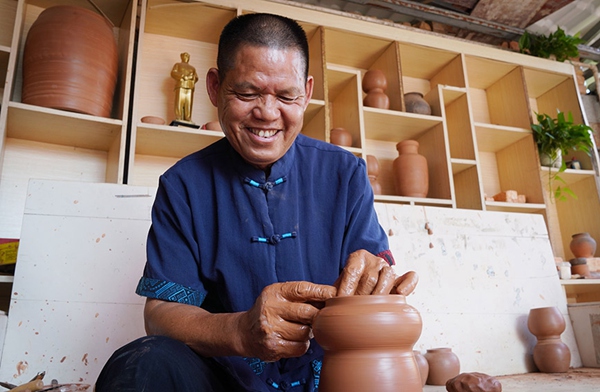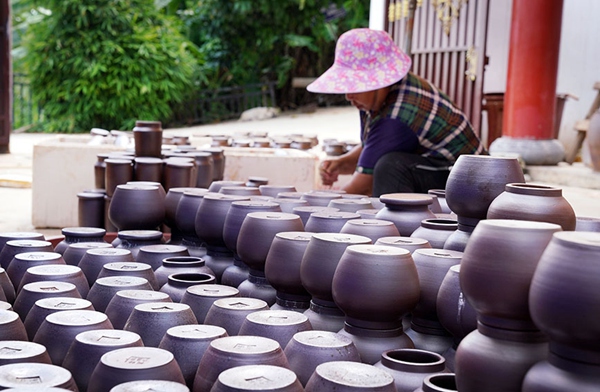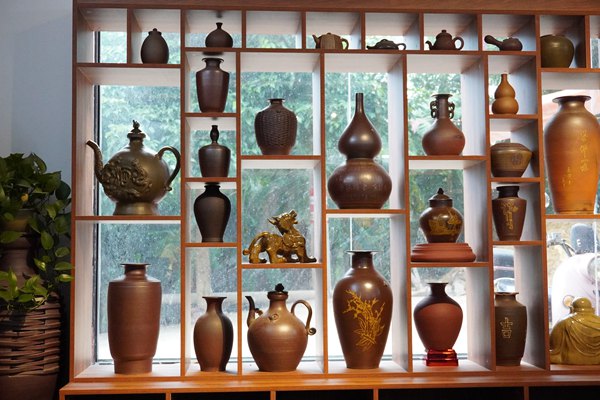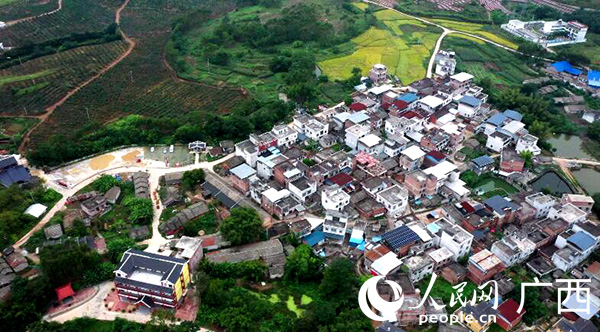Prosperous red clay pottery industry boosts rural revitalization in S China's Guangxi

Yan Changxi, an inheritor of the techniques of making red clay pottery in Zouxu townhip, south China's Guangxi Zhuang Autonomous Region, works on a piece of red clay pottery ware. [Photo/Huang Riqiang]
By making and selling red clay pottery products, villagers in Zouxu township, Binyang county, Nanning, capital of south China's Guangxi Zhuang Autonomous Region enjoy better lives.
This is a result of the town's efforts to vigorously promote the inheritance and innovation of the techniques of making red clay pottery, as well as the development of the red clay pottery industry in recent years.
Zouxu township boasts of a pottery-making tradition dating back more than 900 years. In its heyday, the township had nearly 400 people engaging in making red clay pottery, and its annual output of pottery products reached 690,000 pieces, which were mainly sold to places in Guangxi, south China's Guangdong Province and southwest China's Guizhou and Yunnan provinces.

Photo shows pottery tea caddies. [Photo/Huang Riqiang]
After entering the 20th century, the production of pottery products in the township sunk to a low due to the popularity of plastic and metal household items and the decline in pottery ware demand.
"Back then, only a few old villagers made clay pots in their spare time, and young people worked outside," recalled Yan Changxi, a representative inheritor of Zouxu's traditional techniques of making red clay pottery, who plays a leading role in the red clay pottery industry in the township’s Xiayao village.
"Innovation is the only way forward. Zouxu has to produce diverse, individualized and artistic red clay pottery products that appeal to young people, said Zheng Shaowei, head of Zouxu township.
Since 2013, the township has invited experts and professors in relevant fields to guide locals, injecting new vitality into the techniques of making red clay pottery. It has continued to produce more types of red clay pottery products, ranging from traditional jars and pots to electric tea kettles, electric cookers, tea sets and vases.

Photo shows red clay pottery on display in Zouxu township, south China's Guangxi Zhuang Autonomous Region. [Photo/Peng Chuwen]
Zouxu township has also encouraged veteran potters to return and start a business, and selected artists to study and attend training sessions at universities like Guangxi University and Jingdezhen Ceramic University, mobilizing them to participate in various competitions to improve their skills. This has nurtured three red clay pottery inheritors, including Yan.
In 2016, the techniques of making red clay pottery of Zouxu were listed as an intangible cultural heritage item in Guangxi.
When China proposed the rural revitalization strategy in 2017, Zouxu township seized the opportunity to build the Red Clay Pottery Town, which covers a total area of 2.7 square kilometers and encompasses villages like Xinyao and Xiayao.
Zouxu township built a red clay pottery demonstration base in Xiayao village, which is the core area of the township's red clay pottery industry, in 2021. So far, over 12 million yuan ($1.64 million) has been invested in the base for the construction of infrastructure projects, such as a red clay pottery exhibition hall and restoration of dragon kilns and plants.

Aerial photo shows the red clay pottery demonstration base in Zouxu township, south China's Guangxi Zhuang Autonomous Region. [People's Daily Online/Tan Jiangbo]
The exhibition hall showcases the history and culture of making pottery and red clay pottery products, and provides services like study tours and training sessions. It is where tourists can learn how to make red clay pottery.
"We have integrated culture with tourism, and built distinctive B&B hotels in the base to attract more tourists and boost rural economy," said Si Anxiong, deputy Party chief of Zouxu township.
Once the base is fully completed and put into use, it is expected to help over 2,000 people find jobs near home and bring nearly 500,000 yuan more to the village's collective economy.
Xiayao village thrives on the red clay pottery industry. "Each batch of red clay pottery fired in a kiln can generate 60,000 to 70,000 yuan in income. And a batch of pottery fired in the largest kiln can fetch 100,000 yuan," said Yan, adding that a new dragon kiln was built in the village not long ago, which will further increase production ability.
This can be partly attributed to Yan's efforts. Two years ago, Yan took the lead in establishing the village's pottery art cooperative, which adopts a business model that features cooperation among the cooperative, companies and households, standardizes production processes, and sets quality standards.
Since its establishment, the cooperative has taken an active part in various exhibitions and sales events, and promoted Zouxu's red clay pottery through new media platforms, attracting many enterprises that have placed orders for a long time. It signed a contract with a tea company in Wuzhou city, Guangxi to provide 200,000 pottery tea caddies each year.
“Now, our cooperative has over 40 pottery artists. We also employ 20 pottery artists from other places to meet the demand for orders," said Yan.
Li Shifeng, in his 70s, is a local pottery artist who once stopped making pottery. After the cooperative was established, Li joined it and worked in the pottery-making trade again, earning an average monthly salary of more than 4,000 yuan.
Zheng Ming, Party chief of Zouxu township, said the Zouxu will further develop the red clay pottery industry and promote the in-depth integration of agriculture, culture and tourism to make the town a fine example of rural vitalization.
























